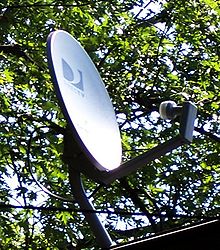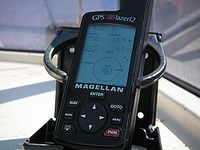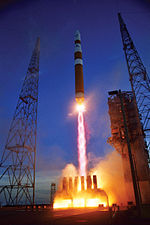Commercial use of space: Difference between revisions
Revert to revision 68326758 dated 2006-08-08 03:21:42 by Oleg Alexandrov using popups |
→Remote sensing: Digital orthophotography != space based. All the high res (better than 15m/pixel) color google earth images are taken from planes, not from space. |
||
| Line 35: | Line 35: | ||
The [[space elevator]] is a proposed new type of space transportation alternative to launching rockets (see also: [[space elevator economics]]). |
The [[space elevator]] is a proposed new type of space transportation alternative to launching rockets (see also: [[space elevator economics]]). |
||
==Remote sensing== |
|||
[[Image:Stadium.PNG|thumb|right|250px|Screenshot of Google Maps (satellite) showing [[Candlestick Park]] in [[San Francisco, CA]]]] |
|||
==Space tourism== |
==Space tourism== |
||
Revision as of 09:55, 26 November 2006
Commercialization of space is the use of outer space for the purpose of generating a profit, either by a corporation or state. Global positioning system (GPS), satellite television and satellite radio are current examples of this concept.
Satellite communication


The satellite communication industry is often broken into four sectors: transponder leasing, subscription satellite services, ground equipment manufacturing, and satellite manufacturing. Together these sectors produced 89 billion dollars in revenue as of 2002, and exhibited a 17% annual growth rate between the years of 1996 and 2002.
Subscription satellite services
Subscription satellite service experienced the majority of the growth seen in the last decade. The reason for this growth can be attributed to the availability of Low Earth Orbit satellite constellations, which enhanced the services of direct-to-home (DTH) television service. In 1994, DirecTV debuted by introducing a dish only 18 inches in diameter. In November of 1999, the Satellite Home Viewer Improvement Act became law, and local stations were then made available in satellite channel packages, fueling the industry’s growth in the years that followed. By the end of 2000, DTH subscriptions totaled over 67 million.
Transponder leasing
Businesses that operate satellites often lease or sell access to their satellites to data relay and telecommunication firms. This service is often referred to as transponder leasing. Between 1996 and 2002, this industry experienced a 15 percent annual growth. The United States accounts for about 32 percent of the world’s transponder market.
Ground equipment manufacturing
For satellites to operate, they need receivers and transmitters on the ground. The manufacturing of satellite uplink and downlink terminals (including VSATs), consumer mobile satellite telephone units, and direct-to-home television receivers and dishes make up the ground equipment manufacturing sector. This sector grew at a quick pace through the latter half of the 1990s as it manufactured equipment for the satellite services sector. Between the years of 1996 and 2002 this industry saw an 14 percent annual increase.
Satellite manufacturing
Commercial satellite manufacturing is defined by the United States government as satellites manufactured for civilian government or non-profit use. Not included are satellites constructed for military use, nor for activities associated with any human space flight program. Between the years of 1996 and 2002, satellite manufacturing within the United States experienced an annual growth of 11 percent. The rest of the world experienced higher growth levels of around 13 percent. Less than 43 percent of the satellites launched in 2002 for commercial use were manufactured in the United States. Fear of technology transfer to foreign governments prompted a 1999 law which allowed the US State Department to control export licensing of satellite technology. These heightened security measures have, some believe, stifled the commercial growth of satellite manufacturing within the US.
Global positioning system

- For a more detailed discussion, see Global Positioning System
Space transportation

The commercial space transportation industry derives the bulk of its revenue from the launching of satellites into the Earth’s orbit. Commercial launch providers typically place private and government satellites into Low Earth Orbit (LEO). In 2002, commercial space transportation garnered 6.6 billion dollars, which made up 6% of the total gross of commercial space activities.
The Federal Aviation Administration (FAA) has licensed four commercial spaceports in the United States: the Virginia Space Flight Center/Wallops Flight Facility, Kodiak Launch Complex, Spaceport Florida/Kennedy Space Center/Cape Canaveral Air Force Station, and the California Spaceport/Vandenberg AFB. Launch sites within Russia and China have added to the global commercial launch capacity. The Delta IV and Atlas V family of launch vehicles are made available for commercial ventures for the United States, while Russia promotes eight families of vehicles. The three largest Russian systems are the Proton, Soyuz, and Zenit.
Between 1996 and 2002, 245 launches were made for commercial ventures while government (non-classified) launches only total 167 for the same period. Commercial space flight has spurred investment into the development of an efficient reusable launch vehicle (RLV) which can place larger payloads into orbit. Several companies such as Venturestar and Pathfinder are currently creating new concepts into RLV design.
The space elevator is a proposed new type of space transportation alternative to launching rockets (see also: space elevator economics).
Space tourism
- For a more detailed discussion, see Space tourism
See also
- Asteroid mining
- Dish Network
- DirecTV
- Sky Angel
- DiSEqC
- Mining the Sky: Untold Riches from the Asteroids, Comets, and Planets
- Rocket Racing League
- Satellite dish
- Satellite television
- Sirius Satellite Radio
- Space manufacturing
- XM Satellite Radio
References
- Futron Corporation (2001) "Trends in Space Commerce". Retrieved Jan. 24, 2006
